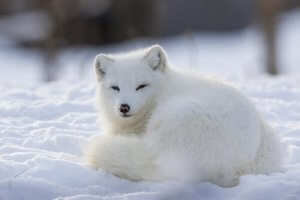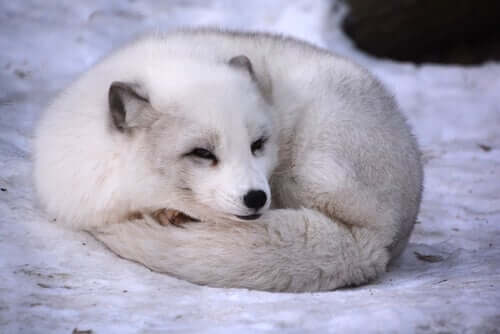The Arctic Fox: A Sociable and Territorial Animal

Also known as the polar fox, the Arctic Fox is a small mammal belonging to the Canidae family that lives at the most northerly point of our planet. In this article, we’ll tell you all about the Arctic fox.
Distribution and habitat
The Arctic fox lives on the tundra in North America, Europe, and Asia. They can be found in Greenland, Iceland (where it is a native animal), Alaska, Canada, and the Bering Sea. It prefers icy areas near the North Pole but also opts for boreal forests up to 2 miles above sea level.
Physical features of the arctic fox
One of the arctic fox’s main physical features is its white fur. It can actually vary in color depending on the time of year and become more gray or brown in the summer. In warmer seasons, its fur gets shorter too.
During winter, its thick layer of fur helps it to survive the very low temperatures (-58 °F) and blend in with the snowy and icy environment. It has also evolved and adapted to have skin over the pads of its feet.

Its large tail is able to curl around its body so it can maintain its body temperature and sleep. They also have small ears to reduce heat loss, but this might be the reason why their hearing is less developed than that of dogs or other fox breeds. Despite this, it can still detect moving prey beneath several inches of snow.
This is a small fox, less than 21 inches long and weighing 9 pounds on average. The females are slightly lighter than the males.
Reproduction and behavior
Mating takes place in March because there are more rodents or sea birds to eat (depending on their location). The females give birth to around 14 puppies on average in May. During the summer, both the male and the female are responsible for raising and caring for their young.
Because of the weather conditions, the mortality rate of the puppies is very high. They need to stay close to the mother in order to get heat and are very vulnerable to attacks from larger predators.

While the puppies are young, the whole family lives in high-up caves. These are made of a complex network of tunnels spread over several hundred feet, with several sun-facing entrances.
Their main prey is the lemming, although they also eat small birds and mammals, eggs, and even seal pups. They also eat carcasses left by polar bears and will eat seaweed and berries if they can’t find meat.
The arctic fox is active the whole year round. They don’t hibernate or migrate during the winter, and they can move over blocks of ice to look for food. Their natural predators are the snowy owl and the wolf.
Social creatures
Polar foxes are quite social creatures and don’t waste time or energy isolating themselves or walking with their partners as other dogs do. They also adapt easily to the presence of human beings and show very little shyness. Sadly, this has made it very easy to hunt them for years.
Whilst today the number has dropped considerably, there are still many ‘experts’ who make coats using the skin of this beautiful animal. It also currently has a ‘Least Concern’ status on the IUCN (International Union for the Conservation of Nature) conservation list.
https://misanimales.com/el-zorro-artico-un-animal-social-y-territorial/
Also known as the polar fox, the Arctic Fox is a small mammal belonging to the Canidae family that lives at the most northerly point of our planet. In this article, we’ll tell you all about the Arctic fox.
Distribution and habitat
The Arctic fox lives on the tundra in North America, Europe, and Asia. They can be found in Greenland, Iceland (where it is a native animal), Alaska, Canada, and the Bering Sea. It prefers icy areas near the North Pole but also opts for boreal forests up to 2 miles above sea level.
Physical features of the arctic fox
One of the arctic fox’s main physical features is its white fur. It can actually vary in color depending on the time of year and become more gray or brown in the summer. In warmer seasons, its fur gets shorter too.
During winter, its thick layer of fur helps it to survive the very low temperatures (-58 °F) and blend in with the snowy and icy environment. It has also evolved and adapted to have skin over the pads of its feet.

Its large tail is able to curl around its body so it can maintain its body temperature and sleep. They also have small ears to reduce heat loss, but this might be the reason why their hearing is less developed than that of dogs or other fox breeds. Despite this, it can still detect moving prey beneath several inches of snow.
This is a small fox, less than 21 inches long and weighing 9 pounds on average. The females are slightly lighter than the males.
Reproduction and behavior
Mating takes place in March because there are more rodents or sea birds to eat (depending on their location). The females give birth to around 14 puppies on average in May. During the summer, both the male and the female are responsible for raising and caring for their young.
Because of the weather conditions, the mortality rate of the puppies is very high. They need to stay close to the mother in order to get heat and are very vulnerable to attacks from larger predators.

While the puppies are young, the whole family lives in high-up caves. These are made of a complex network of tunnels spread over several hundred feet, with several sun-facing entrances.
Their main prey is the lemming, although they also eat small birds and mammals, eggs, and even seal pups. They also eat carcasses left by polar bears and will eat seaweed and berries if they can’t find meat.
The arctic fox is active the whole year round. They don’t hibernate or migrate during the winter, and they can move over blocks of ice to look for food. Their natural predators are the snowy owl and the wolf.
Social creatures
Polar foxes are quite social creatures and don’t waste time or energy isolating themselves or walking with their partners as other dogs do. They also adapt easily to the presence of human beings and show very little shyness. Sadly, this has made it very easy to hunt them for years.
Whilst today the number has dropped considerably, there are still many ‘experts’ who make coats using the skin of this beautiful animal. It also currently has a ‘Least Concern’ status on the IUCN (International Union for the Conservation of Nature) conservation list.
https://misanimales.com/el-zorro-artico-un-animal-social-y-territorial/
All cited sources were thoroughly reviewed by our team to ensure their quality, reliability, currency, and validity. The bibliography of this article was considered reliable and of academic or scientific accuracy.
- Norén, K., Carmichael, L., Dalén, L., Hersteinsson, P., Samelius, G., Fuglei, E., … Angerbjörn, A. (2011). Arctic fox Vulpes lagopus population structure: Circumpolar patterns and processes. Oikos. https://doi.org/10.1111/j.1600-0706.2010.18766.x
This text is provided for informational purposes only and does not replace consultation with a professional. If in doubt, consult your specialist.








